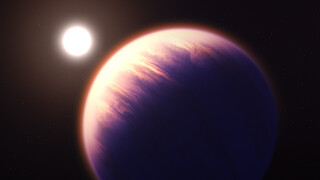These visuals feature artist impressions.
Atmosphere
An atmosphere is a layer (or several layers) of gas that surrounds a planet, or other celestial body.
If a celestial body is surrounded by a layer, or several layers, of gas, then it is said to have an atmosphere. Atmospheres are typically associated with planets and stars, although other celestial bodies can have them as well, such as comets, which have temporary atmospheres. An atmosphere can be acquired in different ways: it can be accreted onto a celestial body by gravitational attraction, or it can be released from a celestial body itself in a process referred to as outgassing. Whether or not a celestial body retains its atmosphere depends on the body’s mass and the temperature of the atmosphere. Generally speaking, the more mass the body has, and the cooler the atmosphere, the better chance it has of hanging onto its atmosphere. For example, a planet that is in close proximity to a star, and which therefore receives a lot of energy, might end up being stripped of its atmosphere — as happened to Mercury in our own Solar System.
One of Webb’s science goals is the exploration of planets and exoplanets. Its large mirror and the excellent sensitivity of its cameras enable more detailed studies of the tiny targets that are exoplanets. Infrared astronomy is also especially useful for studying atmospheres; astronomers use spectroscopy to study them, as the chemical makeup of a planet’s atmosphere leaves a unique fingerprint on the starlight that passes through it. Most of the spectral features in this 'fingerprint' lie at infrared wavelengths.
Among the first measurements returned by Webb was the spectrum of a planet's atmosphere — the most detailed measurement to date of starlight filtering through the atmosphere of a planet outside our Solar System. Among other details previously known about the target, WASP-96 b, the presence of water in the atmosphere was definitively revealed.
It's not only distant exoplanet atmospheres that can be studied by Webb. The telescope will also be used to examine the atmospheres of Solar System planets and their moons in great detail, complementing data being collected by orbiters, rovers, and other telescopes. Already Mars has been imaged by Webb, a combination of images and spectra lending a unique view of the planet and its atmosphere. Thanks to its position, Webb can study short-term phenomena on Mars like dust storms, weather patterns, seasonal changes, and processes that occur at different times (daytime, sunset, and nighttime) of a Martian day.




